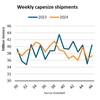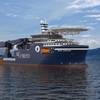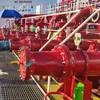DNV GL Boosts LPG as Fuel with Notation
Classification society DNV GL has developed new class rules and a class notation ‘Gas Fuelled LPG’ for using liquefied petroleum gas (LPG) as fuel in anticipation of growing industry interest ahead of IMO 2020 and overall decarbonization of the shipping industry.
The Norway-based international accredited registrar and classification society said that the “Gas fueled LPG” for using LPG as fuel comes as a way of bridging the gaps present in international regulations for such fuels, with the exception of liquefied natural gas (LNG).
Except for LNG, currently all gases and low-flashpoint fuels are subject to the ‘alternative design approach’, which means that they may be used if their safety, reliability and dependability of the systems can be shown to be equivalent to those achieved by new and comparable conventionally fueled main and auxiliary machinery. This can be a time-consuming and costly process and may impede the uptake and expansion of lower emission alternative fuels.
“With the new rules and class notation, we want to offer owners interested in LPG a straightforward path towards compliance with the alternative design approach mandated by the IGF Code,” said Geir Dugstad, Director of Ship Classification & Technical Director at DNV GL – Maritime.
“As the fuel environment within the maritime industry becomes more diverse, it is essential that we continue to broaden the enabling rules and regulation to support these new choices,” he added.
The rules and notation are based on DNV GL’s rules for ships using LNG as fuel but account for the differences in properties and phases between LPG and LNG.
The “Gas fueled LPG” notation covers internal combustion engines, boilers and gas turbines for both gas-only and dual-fuel operations. It also includes requirements for the ship’s fuel supply, considering all aspects of the installation from the bunkering connection up to and including the LPG consumers (main and auxiliary engines, boilers, etc.).
LPG as a fuel can lower a vessel’s emissions to air, both in terms of greenhouse gases and other pollutants. It virtually eliminates sulfur emissions and reduces GHG output by approximately 17 per cent compared to burning HFO or MGO.
LPG could also act as a bridging fuel to ammonia, as the materials used for LPG tanks and systems is, in most cases, suitable for ammonia. With advanced planning, the adjustments needed for a switch to ammonia from LPG could also be minimized.












